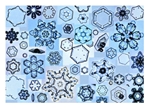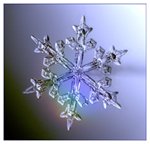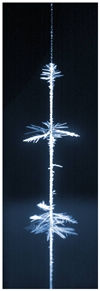Question
What is the internal composition of a snowflake? Are no two snowflakes the same?
Asked By
Nemendahópur í FSu
Answer
 Snow crystals form when the temperature of water in the atmosphere drops below freezing point, either because colder air flows in or because the water rises to colder layers of the atmosphere. But that alone is not enough for the water to freeze. It will be supercooled, i.e. below freezing point and without becoming ice, until it encounters something solid to get the crystallisation process going.
Snow crystals form when the temperature of water in the atmosphere drops below freezing point, either because colder air flows in or because the water rises to colder layers of the atmosphere. But that alone is not enough for the water to freeze. It will be supercooled, i.e. below freezing point and without becoming ice, until it encounters something solid to get the crystallisation process going.
 Typical snow crystals form around minute particles of dust and quickly grow into hexagonal forms that are several micrometers in diameter (1 micrometer is one millionth part of a meter). The initial hexagonal shape results from the shape of the water molecule (one oxygen atom between two hydrogen atoms with a 104 degree angle between them). The edges or corners of the crystal protrude a little and are thus in more contact with the super-saturated air (see also the answer by the same author to the question How do frost roses form on windows? on the Icelandic Web of Science). This is how arms begin to grow out of the crystals.
Typical snow crystals form around minute particles of dust and quickly grow into hexagonal forms that are several micrometers in diameter (1 micrometer is one millionth part of a meter). The initial hexagonal shape results from the shape of the water molecule (one oxygen atom between two hydrogen atoms with a 104 degree angle between them). The edges or corners of the crystal protrude a little and are thus in more contact with the super-saturated air (see also the answer by the same author to the question How do frost roses form on windows? on the Icelandic Web of Science). This is how arms begin to grow out of the crystals.
 The rate of growth of the crystals at this stage is determined by the temperature. In any given temperature range the crystal will grow fastest on one specific plane, and at a different temperature it will grow faster on another plane (direction). As the snow crystal swirls it will be subject to continuous changes in temperature and its direction of growth will be both irregular and will continually change. There are also random imperfections in crystal structure, sometimes more sometimes less, and they can result in the growth taking a different direction from that described above.
The rate of growth of the crystals at this stage is determined by the temperature. In any given temperature range the crystal will grow fastest on one specific plane, and at a different temperature it will grow faster on another plane (direction). As the snow crystal swirls it will be subject to continuous changes in temperature and its direction of growth will be both irregular and will continually change. There are also random imperfections in crystal structure, sometimes more sometimes less, and they can result in the growth taking a different direction from that described above.
 It is also a matter of definition when one can say that two objects are the same; e.g. are there two water molecules that are the same? They all have the same chemical symbols, H2O, which means that they are composed of the same elements and have the same chemical attributes. But there can be other isotopes of elements, both of hydrogen and oxygen. Such isotopes vary significantly in mass from the simple form.
It is also a matter of definition when one can say that two objects are the same; e.g. are there two water molecules that are the same? They all have the same chemical symbols, H2O, which means that they are composed of the same elements and have the same chemical attributes. But there can be other isotopes of elements, both of hydrogen and oxygen. Such isotopes vary significantly in mass from the simple form.
 If we play a little with numbers we can note that in a typical small snow crystal there are 1018 molecules of water ( which means 1.000.000.000.000.000.000!). One of every hydrogen atoms differs from the others and is called deuterium. In our example that would mean that about 1015 hydrogen atoms in every snow crystal (of 1000.000.000.000.000!) differ from the others. Deuterium occurs at random in the structure and thus adds to the variety of structure of the crystals. Oxygen isotopes are less likely to do this. On their way to the ground, snow crystals usually join with one another to form the snow flakes we all know so well. Snow flakes are often composed of between 2 and 200 crystals.
Though there is certainly a huge number of snow flakes in the world, they are much fewer than the possible forms of such flakes. The conclusion is that it is almost impossible to find two exactly identical snow flakes.
Translated by Paul Richardson.
If we play a little with numbers we can note that in a typical small snow crystal there are 1018 molecules of water ( which means 1.000.000.000.000.000.000!). One of every hydrogen atoms differs from the others and is called deuterium. In our example that would mean that about 1015 hydrogen atoms in every snow crystal (of 1000.000.000.000.000!) differ from the others. Deuterium occurs at random in the structure and thus adds to the variety of structure of the crystals. Oxygen isotopes are less likely to do this. On their way to the ground, snow crystals usually join with one another to form the snow flakes we all know so well. Snow flakes are often composed of between 2 and 200 crystals.
Though there is certainly a huge number of snow flakes in the world, they are much fewer than the possible forms of such flakes. The conclusion is that it is almost impossible to find two exactly identical snow flakes.
Translated by Paul Richardson.
Um þessa spurningu
Dagsetning
Published27.12.2005
Category:
Keywords
Citation
Halldór Svavarsson and Þorsteinn Vilhjálmsson. „What is the internal composition of a snowflake? Are no two snowflakes the same?“. The Icelandic Web of Science 27.12.2005. http://why.is/svar.php?id=5514. (Skoðað 25.4.2024).
Authors
Halldór Svavarssondósent við tækni- og verkfræðideild Háskólans í ReykjavíkÞorsteinn Vilhjálmssonprofessor emeritus, editor in chief of Vísindavefurinn 2000-2010 and editor in chief of Evrópuvefurinn 2010-2011



